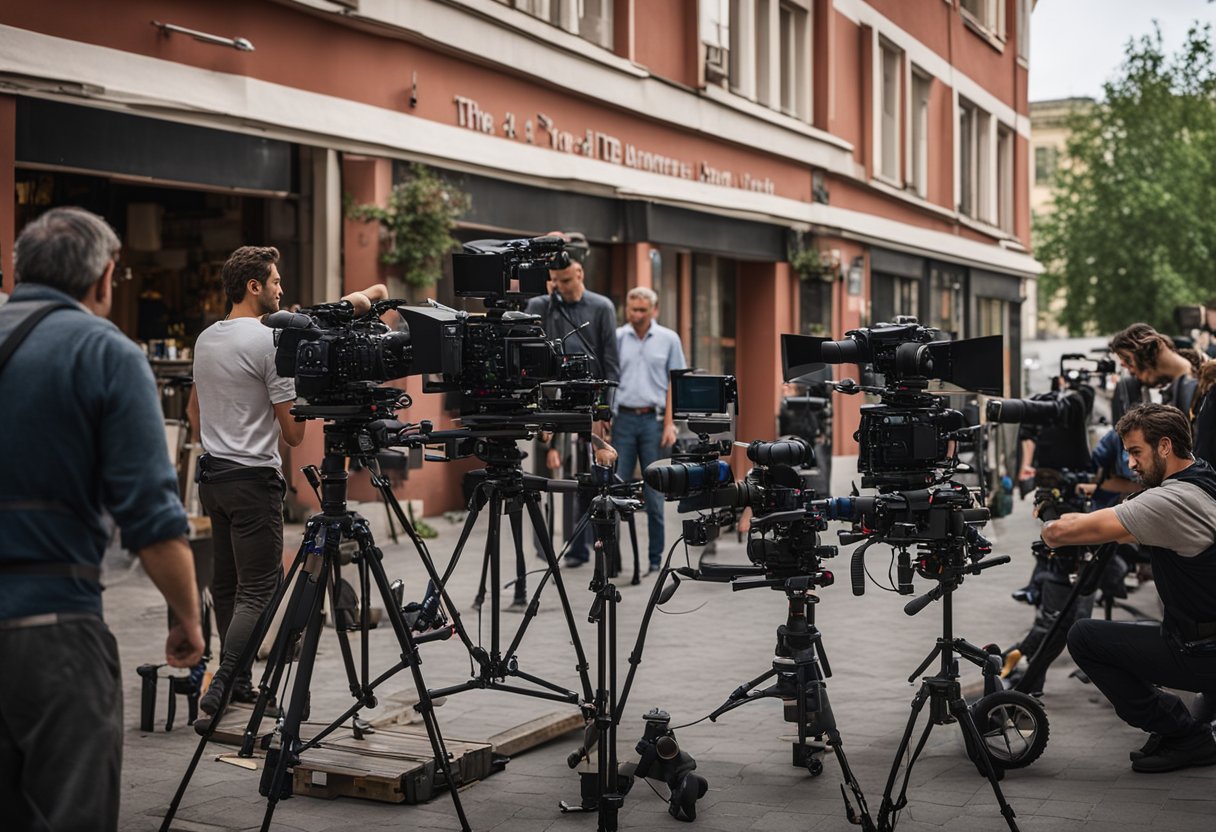The Red Danube, a 1949 film, brought together an ensemble of distinguished actors to create a post-World War II era narrative. Set in Vienna, this film touches on the complex themes of repatriation and the stark post-war realities faced by different characters. Directed by George Sidney, the motion picture offers a blend of drama, romance, and war, encapsulating the spirit of its time through both its story and its cast.

Key players in The Red Danube include Walter Pidgeon, who assumes the lead role of British Colonel Michael S. ‘Hooky’ Nicobar, guiding the movie’s central plot with his seasoned portrayal of leadership in a war-torn world. Ethel Barrymore’s performance as The Mother Superior adds a substantial moral dimension to the film, while prominent names like Peter Lawford and Angela Lansbury, playing Major John ‘Twingo’ McPhimister and Audrey Quail respectively, round out the main cast with their compelling characters, each bringing a unique dynamic to the movie’s intricate narrative.
In setting its scene against the backdrop of Vienna in the aftermath of World War II, The Red Danube presents a poignant exploration of human emotion, conflict, and the yearning for a semblance of peace. The film endeavors to reflect the uncertainty and complex geopolitical landscapes of the time, delivered through the powerful performances of its star-studded cast.
Let’s take a look at the full cast of the Red Danube.
Production Details
“The Red Danube,” a film released in 1949, was a notable production from Metro-Goldwyn-Mayer (MGM), a studio renowned for its influential presence in the Golden Age of Hollywood. MGM, operating under its parent company Loew’s, Inc., handled both the production and distribution of the film.
The crew behind “The Red Danube” included prominent figures in the film industry at the time. George Sidney directed the picture, bringing his experienced eye to the complex themes of the narrative. Carey Wilson served as the producer, ensuring the film’s progression from script to screen.
The screenplay, shaping the story being told, was a collaborative effort. Gina Kaus and Richard Llewellyn worked together to adapt the material from Bruce Marshall’s novel, providing the foundation for the actors’ performances.
| Key Crew Members | Role |
|---|---|
| George Sidney | Director |
| Carey Wilson | Producer |
| Gina Kaus | Writer |
| Richard Llewellyn | Writer |
Metro-Goldwyn-Mayer was responsible for the ensemble that brought “The Red Danube” to life, employing their considerable resources and influence in the industry to craft a cinematic piece reflective of the era’s storytelling and production values.
Historical Context

The film “The Red Danube,” released in 1949, is set against the backdrop of post-World War II tensions that defined the Cold War era. The narrative unfolds in Vienna, specifically in the British Zone, highlighting the city’s division among the Allies after the defeat of the Axis powers.
During this period, Vienna, much like Berlin, was segmented into zones controlled by the United States, the Soviet Union, the United Kingdom, and France. The city became a microcosm of the escalating political and ideological divides characteristic of the Cold War.
One of the prominent historical events alluded to in the film’s setting is Operation Keelhaul, the forcible repatriation of individuals to the Soviet Union. This operation saw the Allies transfer prison camp detainees back to the USSR, often against their will. The concept of repatriation as depicted in “The Red Danube” underscores the complexities of the geopolitics during this era, as many individuals feared persecution under Stalin’s regime.
The film, while a dramatization, gives viewers a glimpse into the dilemmas faced by those caught between the desire for freedom and the grim realities of the geopolitical landscape—a landscape where individual fates were often determined by superpower rivalry. The implications of these historical events are deeply woven into the film’s narrative, presenting a sobering reflection on the era’s socio-political climate.
Plot Overview
“The Red Danube,” set in the post-World War II era, unfolds in Vienna, a city divided among the Allied powers. As the film advances, it intricately weaves themes of faith, communism, and the search for freedom amid a pervasive atmosphere of doubt and political tension.
The narrative centers on British Colonel Michael S. “Hooky” Nicobar, played by Walter Pidgeon, who is responsible for repatriating Soviet citizens. These are individuals who have been displaced by the war and are now under his charge to ensure their return to the Soviet Union. However, many of these citizens harbor a deep reluctance to repatriate due to the fear of what awaits them under Stalin’s rule.
The plot thickens with the introduction of a Russian ballerina who strives to escape the grasps of the KGB and pursues political asylum within the British zone of Vienna. This subplot accentuates the core conflict between ideologies, highlighting the clashing principles of authoritarian communism and the Western ideal of individual freedom.
Throughout the film, characters grapple with moral ambiguities and the stark realities of the Cold War era. The notions of duty versus conscience and the cost of obedience come to the forefront, exposing the stark contrast between public orders and personal beliefs. The film does not shy away from showcasing the internal and external conflicts that define this tumultuous period in history, all within the brooding and beautifully captured city of Vienna.
Cast and Characters
The cast of The Red Danube features a mix of illustrious actors who bring depth and distinction to their roles. Key figures in the cast include seasoned professionals like Walter Pidgeon and Ethel Barrymore, as well as stars such as Angela Lansbury and Peter Lawford.
Main Cast
- Walter Pidgeon as Col. Michael ‘Hooky’ Nicobar
- Ethel Barrymore as The Mother Superior
- Peter Lawford as Maj. John ‘Twingo’ McPhimister
- Angela Lansbury as Audrey Quail
- Janet Leigh as Olga Alexandrova, also known as Maria Buhlen
Supporting Cast
- Louis Calhern as Colonel Piniev
- Francis L. Sullivan as Colonel Humphrey ‘Blinker’ Omicron
- Melville Cooper as Private David Moonlight
- Tamara Shayne and Konstantin Shayne in unspecified supporting roles
Character Details
- Maria (played by Janet Leigh) is depicted as a Russian ballerina who embodies both innocence and resilience
- Mother Superior (portrayed by Ethel Barrymore) provides a commanding presence, pivotal in challenging the characters’ moral compasses
The characters range from military personnel, such as Col. Nicobar and Maj. McPhimister, to Soviet entities represented in the film. Mother Auxilia, a character played by Tamara Shayne, contributes to the complexity of the convent scenario displayed in the film. The plot revolves around these characters’ interactions, offering a narrative that captures the post-World War II sentiment intertwined with individual stories of hardship and hope.
Production Crew

The production crew of “The Red Danube” brought together seasoned industry professionals to create a movie that was both technically proficient and artistically expressive. The film’s success hinged on the collaborative efforts of directors, writers, musicians, and various design and technical experts.
Director & Writers
Director: George Sidney efficiently steered “The Red Danube,” known for his work on several high-profile MGM productions. Writers: The narrative was shaped by the creative writing team that included Bruce Marshall, who provided the source material, along with Gina Kaus and Arthur Wimperis, who worked on the screenplay adaptation.
Musical Score
Music by: The film’s musical landscape was crafted by Miklós Rózsa, renowned for his rich, dramatic compositions that were an asset to the film’s atmosphere.
Cinematography
Cinematography by: Pivotal to the visual storytelling was Charles Rosher, whose mastery with the camera lens captured the nuanced performances and the film’s setting with clarity and depth.
Art Direction
Art Direction by:
- Cedric Gibbons
- Hans Peters
Both Gibbons and Peters contributed their considerable expertise to create an authentic and evocative visual environment, integral to the film’s storytelling.
Set Decoration
Set Decoration by: Edwin B. Willis complemented the art direction with detailed and period-appropriate set decoration, enhancing the film’s realism.
Makeup and Hair
Makeup by: Jack Dawn ensured the cast’s features were suitable for the era and the emotional demands of the narrative. Hair Styling by: Sydney Guilaroff provided the hairstyles that completed the transformative looks required for the characters in “The Red Danube.” Their combined efforts established the authenticity of the period within the film.
Themes and Motifs
“The Red Danube,” a classic film set in the aftermath of World War II, is a tapestry rich with themes and motifs that speak to the era’s anxieties and ideologies.
Communism and the Cold War tensions form the backdrop of the narrative. The film delves into the complexities of repatriation, where Soviet citizens are being forcefully returned to their homeland. This element thematically underlines the lack of freedom in communist societies and the West’s response to the growing ideological divide.
The personal struggle for freedom is personified by the character of the Russian ballerina, creating a stark contrast between the oppression of Communist regimes and the perceived liberty in the West. Her yearning to defect becomes a powerful motif of individual liberty against state control.
Repatriation, as depicted in the film, is at times tragic. The forced return of individuals to the Soviet Union highlights the theme of tragedy, resonating with the audience’s understanding of the period’s political complexity and the personal toll of such policies.
The characters’ confrontations with faith and doubt give depth to the narrative. Their moral dilemmas represent the broader societal uncertainties about the right course of action during such turbulent times, indicating a world grappling with unprecedented changes.
The tension between these themes shapes a narrative that is not merely historical but also reflective of the universal human condition amidst political upheaval.
Critical Reception & Legacy

When “The Red Danube,” an American drama film released in 1949, premiered, it encountered a mixed bag of reactions from critics. Despite the film being rooted in a 1947 novel, the transition from page to screen involved artistic liberties to adapt to the cinematic form.
The 1949 film showcased notable performances by an ensemble cast, which included Walter Pidgeon, Ethel Barrymore, Peter Lawford, and Angela Lansbury. The story, set in post-World War II Vienna, broached the complex topic of Soviet repatriation policies. At its release, the film was acknowledged for tackling the moral quandaries of the period; however, some reviewers described its execution as lukewarm.
- Plot Reception:
- Acknowledged: The film’s serious take on post-war repatriation issues
- Criticized: Some believed the storytelling could have been more compelling
- Performance Reception:
- Walter Pidgeon: Praised for his portrayal of Col. Michael “Hooky” Nicobar
- Supporting Cast: Received commendation for bringing depth to challenging roles
The legacy of “The Red Danube” remains nuanced. It neither soared as a timeless classic nor faded into obscurity. The film retains historical value for its earnest attempt to depict the Cold War’s early tensions through cinema. While contemporary audiences might not find it as engaging as modern films, its exploration of challenging themes relevant to its era commands a certain level of respect and offers insight into the period’s mindset. The artistic endeavor to translate a 1947 novel into a 1949 American drama film is a testament to the film industry’s ongoing effort to reflect societal issues of the time.
Box Office and Financials
“The Red Danube,” a classic film released in 1949, encountered the hope and challenge of recouping its production and marketing costs upon its release. When assessing the film’s financial success, two critical figures are often cited: the estimated gross earnings of $1.96 million and the reported production budget.
When breaking down the box office intake, a key metric is the initial gross earnings. The film managed to accumulate an estimated total of around $1.96 million, which serves as a benchmark for its financial performance.
The budget of the film must be considered in coordination with the box office takings to get a sense of profit and loss. Although specific budget figures for “The Red Danube” are not readily available, a similar film of the era might accrue costs around $1.86 million, adjusting for inflation and production values. This hypothetical figure, when juxtaposed with the gross earnings, can provide an indication of the film’s market penetration and overall financial success.
It is noteworthy that financial success in the movie industry also depends significantly on additional revenue streams such as home video sales, television distribution rights, and merchandise, which might not be reflected in the initial box office numbers.
To further contemplate the financial landscape the film faced, here is a simplified representation:
| Category | Amount (est.) |
|---|---|
| Gross Earnings | $1.96 Million |
| Production & Marketing | $1.86 Million |
In summary, “The Red Danube” yielded a gross earning that might slightly surpass its production costs, indicating a potential modest financial gain. While detailed financial records from that period are scarce, the film’s performance remains a testament to the post-war cinema’s capacity to draw audiences.
Release and Distribution
“The Red Danube,” a drama film, was released to theaters on October 14, 1949. It garnered attention due to its notable cast and the involvement of prominent filmmakers of the era. Initially titled “Vespers in Vienna,” the movie underwent a name change before its distribution to the public. This could be attributed to marketing considerations or the film’s thematic content aligning better with the final title.
The distribution of “The Red Danube” was overseen by MGM (Metro-Goldwyn-Mayer), a significant player in the film industry. MGM’s extensive distribution network ensured that the film reached a wide audience across different regions.
Following its theatrical run, the film has been featured on Turner Classic Movies (TCM), a television network known for broadcasting classic films. TCM has helped in preserving the film’s legacy and introducing it to new generations of film enthusiasts.
Below is a concise timeline that highlights the key points in the film’s distribution history:
- 1949: Theatrical release as “The Red Danube”
- Title Variations: Known in its development stage as “Vespers in Vienna”
- TV Broadcast: Featured on Turner Classic Movies for periodic screenings
It’s worth noting that the distribution pattern for “The Red Danube” was typical for films of that era, benefiting from the strong network of a major studio like MGM and later from specialized broadcasters like TCM, enhancing its accessibility and longevity in popular culture.

